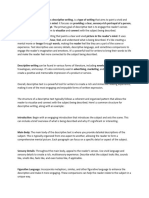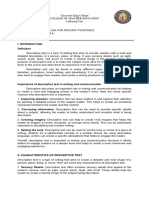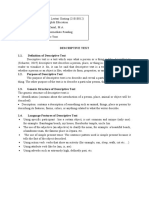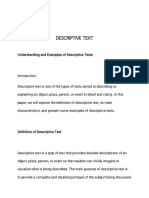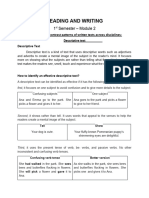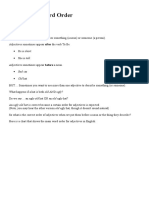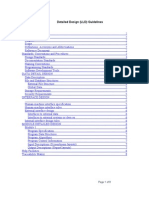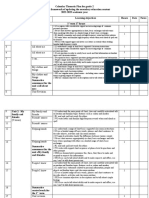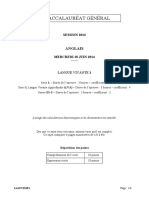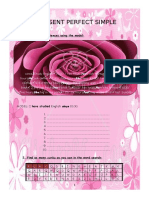What is Descriptive Text?
A descriptive text is a type of text that aims to describe a person, place, object, or event in
such a vivid and detailed way that the reader can imagine it clearly—as if they are seeing,
hearing, smelling, or feeling it themselves.
Its main purpose is to give the reader a clear picture by using specific details and sensory
language (what you see, hear, smell, feel, or taste).
Generic Structure of Descriptive Text
1. Identification
o Introduces the thing/person/place being described.
o Gives general information about the topic.
o Example: “The Whispering Woods is a quiet forest located beyond the old
bridge.”
2. Description
o Describes the characteristics or features in detail (appearance, smell, sound,
feeling, etc.).
o Uses imagery, figurative language, and adjectives.
o Example: “Tall trees stand like silent guards. The forest floor is covered in moss
and crunchy leaves.”
Characteristics of Descriptive Text
● Focuses on a single subject: Describes one specific person, place, or thing.
● Uses sensory details: Appeals to the five senses (sight, sound, smell, taste, touch).
● Employs vivid adjectives and adverbs: Uses strong descriptive words.
● Often uses figurative language: Similes and metaphors to create comparisons.
● Generally uses present tense.
Language Features of Descriptive Text
1. Adjectives
o Words that describe nouns (size, color, shape, feeling).
o Examples: tall, ancient, fragrant, soft, golden
2. Sensory Details
o Descriptions that appeal to the five senses: sight, sound, smell, taste, and touch.
o Examples: the sharp scent of pine, the rustle of dry leaves
3. Figurative Language
o Including similes, metaphors, and personification to create imagery.
� oExamples: “like a forgotten dream,” “trees stand like sentinels,” “the piano sang
a lonely tune”
4. Simple Present Tense
o Descriptive texts usually use the simple present tense because they describe facts
or states that are generally true.
o Example: “The garden smells of roses.”
Examples of Topics in Descriptive Text
• A favorite place (e.g., your bedroom, a beach, a school)
• A person you admire (e.g., your grandfather, a celebrity, a teacher)
• An object (e.g., an old piano, a bicycle, a keepsake)
• An animal (e.g., a pet cat, a lion in the zoo)
• A special event (e.g., a festival, a family gathering)
Why is Descriptive Text Important?
• It helps develop your observation and writing skills.
• It builds your ability to express experiences and impressions vividly.
• It's useful in narrative writing, poetry, and even creative essays.
Example 1: Describing a Person
My Grandfather, The Storyteller
My grandfather, Papa Joe, is a gentle, wise, and kind-hearted man carved from oak and
sunshine, a living figure of strength and tenderness. His weathered, deeply lined face is a
roadmap of laughter and love, each wrinkle whispering stories of joyful days and difficult nights.
His pale blue, slightly faded eyes still gleam with a mischievous sparkle, like distant stars on a
clear, chilly night.
His rough, calloused hands, shaped by years of working in his lush, fragrant garden, are
surprisingly gentle when they rest on my shoulder or ruffle my hair. I can always smell the
faint, comforting scent of pipe tobacco mixed with the earthy aroma of damp soil and sweet,
blooming roses. His voice is a low, soothing rumble, like distant thunder, and when he speaks,
each word seems to wrap around me like a warm, woollen blanket.
He tells stories filled with fierce dragons, brave knights, and magical lands, painting each
scene so vividly that I feel the chill of the mountain winds or the heat of a desert sun through his
words. Though he walks with slow, deliberate steps now and rests more often,
his cheerful, vibrant spirit shines through in every laugh, every glance, and every tale he spins.
Sitting beside him feels like sitting next to a living time machine—someone who carries the past
in his voice and lights the future with his stories.
�Generic Structure of Descriptive Text
1. Identification
“My grandfather, Papa Joe, is a gentle, wise, and kind-hearted man carved from oak and
sunshine…”
→ Introduces the subject and gives a general impression.
2. Description
• Physical traits: “weathered, deeply lined face… pale blue eyes… calloused hands…”
• Personality: “wise, cheerful, vibrant spirit…”
• Voice and storytelling: “low, soothing rumble… wraps around me like a warm
blanket…”
• Scent: “faint, comforting scent of pipe tobacco… earthy aroma of damp soil…”
• Movement and presence: “slow, deliberate steps… living time machine…”
Language Features
1. Adjectives (to describe noun qualities)
• gentle, wise, kind-hearted, weathered, pale blue, rough, calloused, fragrant,
comforting, warm, slow, cheerful, vibrant, living, magical, fierce, brave, soothing
2. Sensory Details (to appeal to the five senses)
• Sight:
“weathered face,” “twinkle like distant stars,” “lush, fragrant garden,” “vivid scenes”
• Touch:
“gentle hands,” “rough and calloused,” “warm woolen blanket”
• Smell:
“faint scent of pipe tobacco,” “earthy aroma of damp soil,” “sweet, blooming roses”
• Sound:
“low, soothing rumble,” “voice like distant thunder”
• Feeling/Emotion:
“wrap around me like a warm blanket,” “living time machine” evokes comfort and
wonder
�Example 2: Describing a Place
The Whispering Woods
Just beyond the old stone bridge lies the Whispering Woods, a mystical place shrouded in
timeless beauty. Towering ancient trees stand like silent sentinels, their interwoven
branches arching overhead to form a cathedral-like ceiling that filters the light
in dappled, shifting patterns. On the forest floor, a soft bed of emerald moss and crunchy fallen
leaves cushions each step. The air is thick with the faint, earthy aroma of damp
soil and decaying wood, occasionally brightened by the sweet perfume of wild honeysuckle,
especially in summer.
The only sounds that fill the space are the gentle rustle of leaves, a perpetual whisper that
feels as if it carries the stories of centuries long gone. These whispers are occasionally interrupted
by the sharp tap-tap of a woodpecker or the cheerful chirping of unseen birds, tucked away in
the foliage. Deeper within, a narrow, winding path snakes through the trees, its entrance barely
visible—like a secret invitation into a cool, shadowy embrace, beckoning curious hearts to
venture further into the unknown.
Generic Structure of Descriptive Text
1. Identification
→ "The Whispering Woods": Introducing the place to be described.
2. Description
• Trees: Ancient, towering, silent, interwoven branches, cathedral ceiling
• Sunlight & Floor: Dappled patterns, shifting mosaics, emerald moss, crunchy
leaves
• Scent: Earthy, damp soil, decaying wood, wild honeysuckle
• Sound: Rustling leaves, woodpecker tap-tap, chirping birds
• Path: Narrow, winding, cool, shadowy embrace
Language Features
1. Adjectives (to give detailed descriptions):
Ancient, silent, interwoven, cathedral, dappled, shifting, emerald, crunchy, faint,
earthy, damp, decaying, sweet, wild, gentle, perpetual, sharp, cheerful, unseen,
narrow, winding, visible, cool, shadowy
2. Metaphors & Imagery:
• "Trees stand like silent sentinels": personification/metaphor
• "Branches interwoven to form a cathedral ceiling": metaphorical comparison that
adds grandeur
• "Cool, shadowy embrace": personifies the forest as welcoming and mysterious
� 3. Sensory Details:
• Sight: Ancient trees, dappled sunlight, emerald moss, winding path
• Sound: Rustling leaves, tap-tap of woodpecker, birds chirping
• Smell: Damp soil, decaying wood, sweet honeysuckle
• Touch: Crunchy leaves underfoot, cool air within the forest
Example 3: Describing an Object
My Old, Trusty Backpack
My old, trusty backpack is more than just a bag; it's a loyal companion, a silent witness to
countless adventures. It's a faded navy blue, almost grey in places where the sun has
bleached its sturdy canvas. The main zipper, once sleek and silver, now has a comforting, worn
brassiness, and the pull-tab is smooth from years of use. Two small, patched holes on the
side, remnants of a forgotten hiking trip, add character rather than detract from its charm.
Inside, it smells faintly of old books and dried leaves, a comforting aroma that reminds
me of quiet afternoons in the library and brisk walks in the autumn woods. The straps, though
a bit frayed at the edges, still feel surprisingly soft against my shoulders, molding perfectly to my
form. It might not be new or flashy, but its scuffs and faded patches tell a thousand stories,
making it truly irreplaceable.
Generic Structure
1. Identification
o “My old, trusty backpack” — introduces the subject clearly and emotionally.
2. Description
o Colour & Wear: Faded navy blue, sun-bleached areas, grey patches.
o Material: Sturdy canvas.
o Zipper & Pull-tab: Brassiness, smoothness from use.
o Damage: Patched holes with backstory (hiking trip).
o Scent: Old books, dried leaves, comforting and nostalgic.
o Straps: Frayed edges, soft feel, melded comfort.
o Impression: Not flashy but meaningful, irreplaceable.
Language Features
1. Adjectives (descriptive words):
• old, trusty, loyal, silent, faded, navy, sturdy, sleek, silver, comforting, worn, brassiness,
smooth, small, patched, forgotten, old (again), dried, quiet, brisk, frayed, soft, new,
flashy, irreplaceable
�2. Metaphor & Figurative Language:
• “It’s a loyal companion, a silent witness” — personification of the backpack.
• “Tells a thousand stories” — metaphor for the memories associated with wear and tear.
• “Molding perfectly to my form” — suggests emotional and physical comfort.
3. Sensory Details:
• Sight: faded navy blue, patched holes, scuffs, sun-bleached fabric
• Smell: faint scent of old books, dried leaves
• Touch: sturdy canvas, smooth pull-tab, soft frayed straps
• Emotion/Memory: reminds me of quiet afternoons, brisk walks, hiking trips











